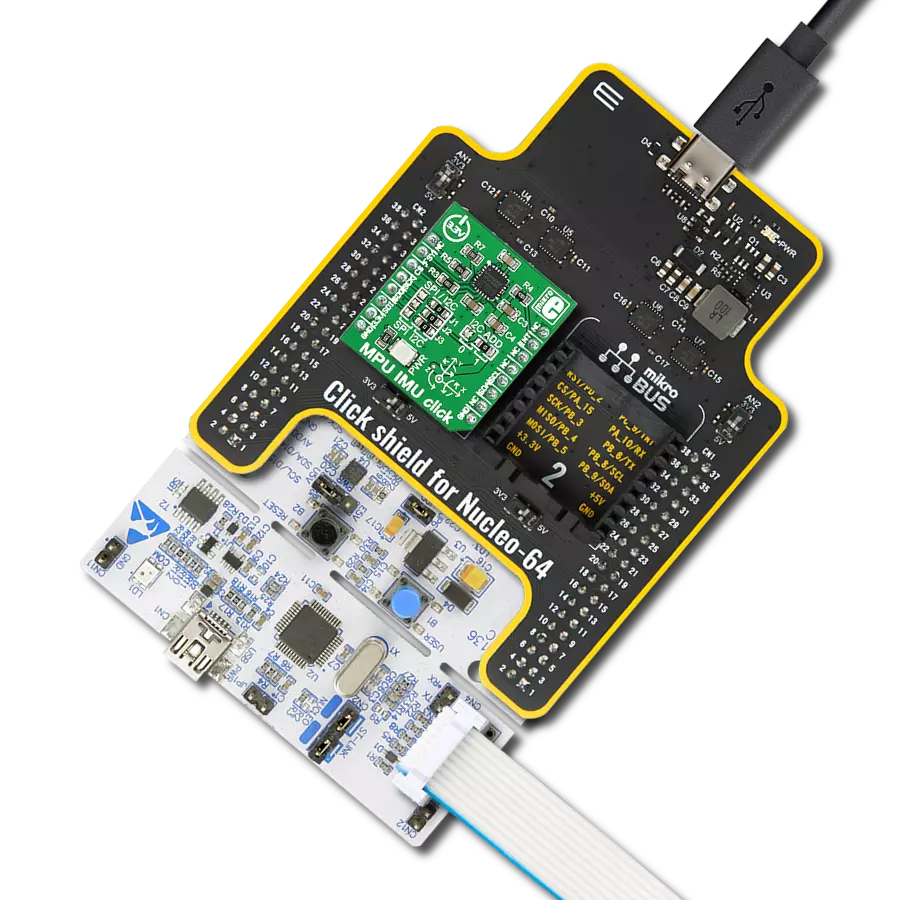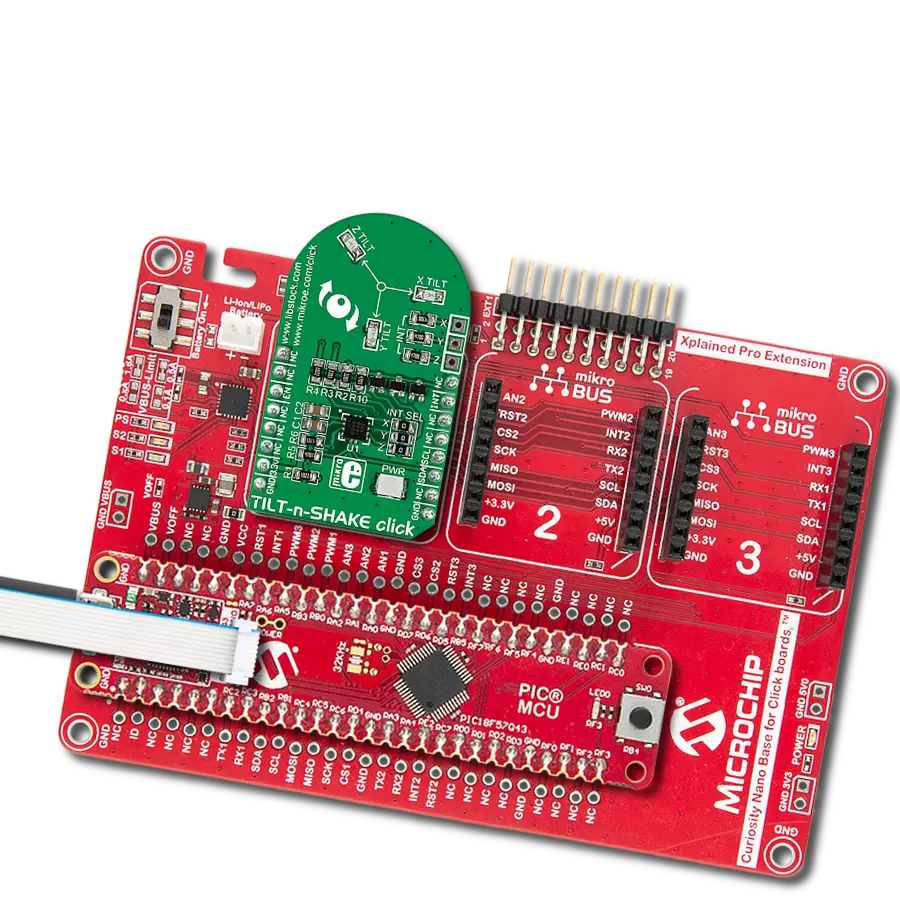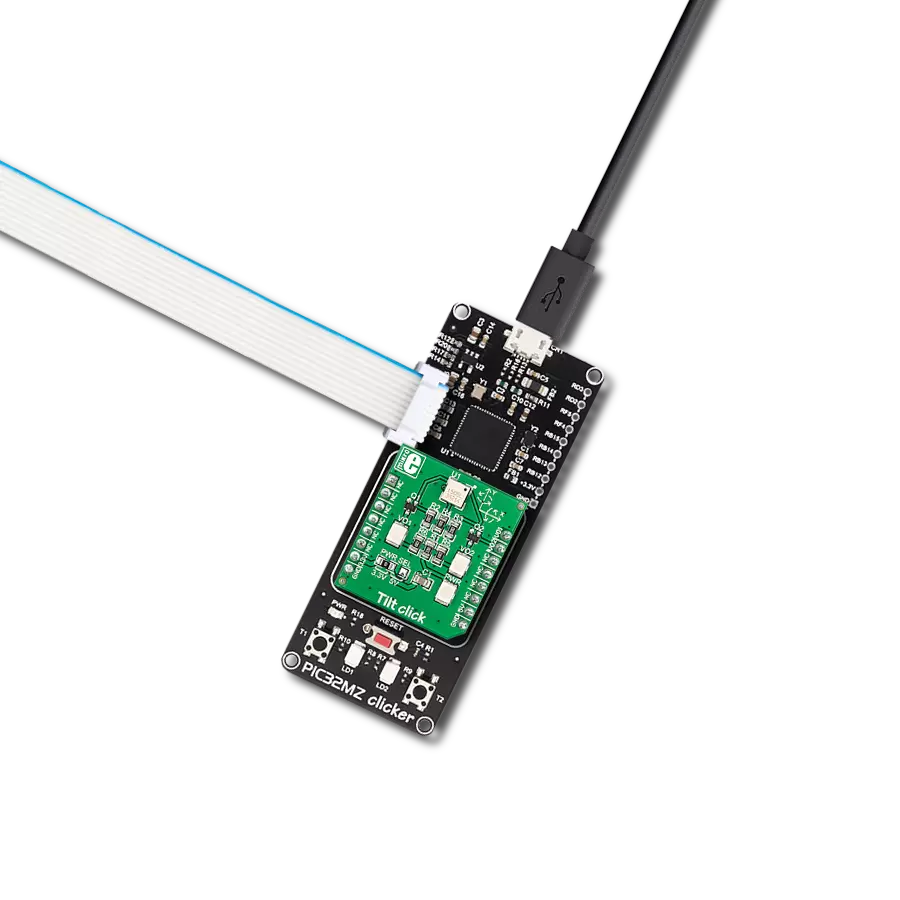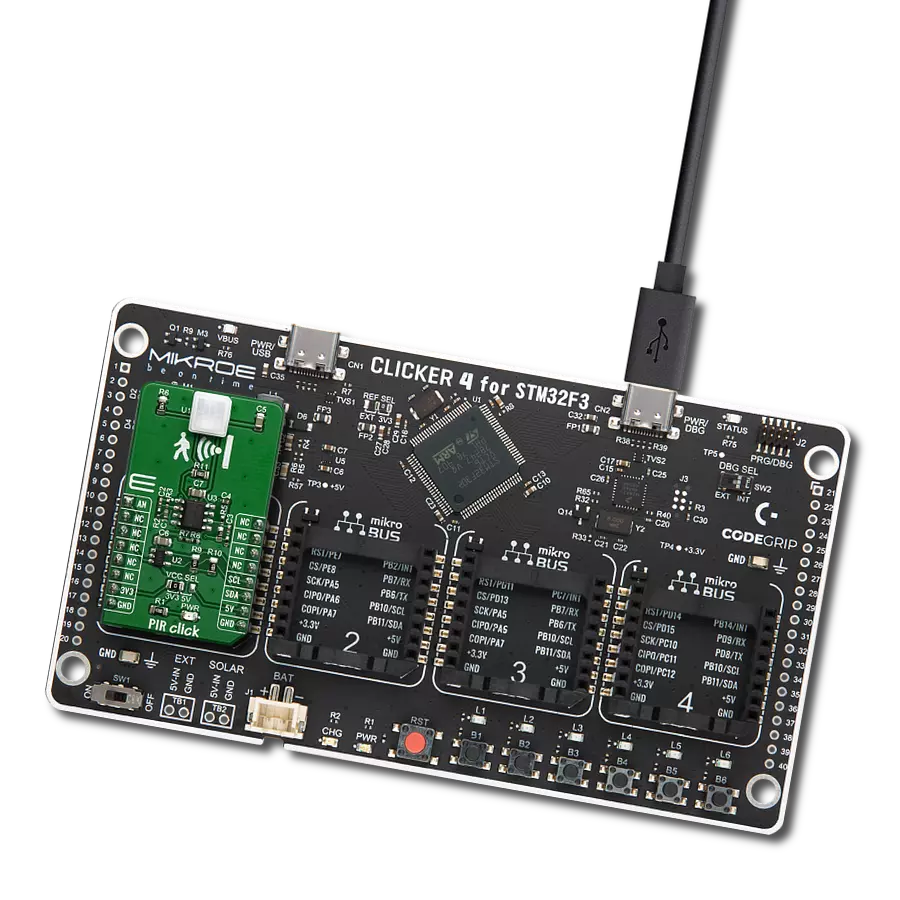Unlock a realm of possibilities with our 9DOF low-power solution, where motion and magnetometer capabilities unite to redefine what's achievable in efficiency-driven applications without sacrificing the accuracy you demand
A
A
Hardware Overview
How does it work?
9DOF 2 Click is based on the ICM-20948, a high performance, 9-axis MotionTracking™ IC from TDK Invensense. ICM-20948 also supports an auxiliary I2C interface to external sensors, which offers greater system flexibility. The output of each MEMS is processed and digitized by a separate sigma-delta 16-bit A/D converter (ADC). Three-axis gyroscope MEMS can be programmed to measure the rotation about each axis in four different ranges of rotational speed (degrees per angle, DPS): ±250, ±500, ±1000, and ±2000. Three-axis accelerometer MEMS can be programmed to measure the acceleration along each axis in four different acceleration ranges: ±2g, ±4g, ±8g, and ±16g. Three-axis magnetometer can do a full-scale measurement of ±4900 µT. Interrupt functionality is configured via the Interrupt Configuration register. Configurable items include the INT
pin configuration, the interrupt latching and clearing method, and triggers for the interrupt. The interrupt is routed to the INT pin of the mikroBUS™. A FIFO buffer helps to reduce the processing load further, offering temporary storage for the output data. The ICM-20948 contains a FIFO of size 512 bytes (FIFO size will vary depending on the DMP feature-set) accessible via the Serial Interface. The FIFO configuration register determines which data is written into the FIFO. Possible choices include gyro data, accelerometer data, temperature readings, auxiliary sensor readings, and FSYNC input. Synchronization with an external digital signal is possible over the FSYNC pin. This pin is routed to the PWM pin of the mikroBUS™, labeled as SNC. The embedded Digital Motion Processor (DMP) within the ICM-20948 offloads computation of
motion processing algorithms from the host processor. The DMP acquires data from accelerometers, gyroscopes, and additional third-party sensors such as magnetometers and processes the data. The resulting data can be read from the FIFO. The DMP has access to the external pins, which can be used for generating interrupts. ICM-20948 supports SPI and I2C communication interfaces, but only the SPI interface is used on the 9DOF 2 Click. The TXB0108 bidirectional voltage level translator converts the voltage level between ICM-20948 and 3.3V MCU. This Click Board™ uses only the SPI communication interface. It is designed to be operated only with 3.3V logic levels. A proper logic voltage level conversion should be performed before the Click board™ is used with MCUs with logic levels of 5V.
Features overview
Development board
Nucleo-64 with STM32F446RE MCU offers a cost-effective and adaptable platform for developers to explore new ideas and prototype their designs. This board harnesses the versatility of the STM32 microcontroller, enabling users to select the optimal balance of performance and power consumption for their projects. It accommodates the STM32 microcontroller in the LQFP64 package and includes essential components such as a user LED, which doubles as an ARDUINO® signal, alongside user and reset push-buttons, and a 32.768kHz crystal oscillator for precise timing operations. Designed with expansion and flexibility in mind, the Nucleo-64 board features an ARDUINO® Uno V3 expansion connector and ST morpho extension pin
headers, granting complete access to the STM32's I/Os for comprehensive project integration. Power supply options are adaptable, supporting ST-LINK USB VBUS or external power sources, ensuring adaptability in various development environments. The board also has an on-board ST-LINK debugger/programmer with USB re-enumeration capability, simplifying the programming and debugging process. Moreover, the board is designed to simplify advanced development with its external SMPS for efficient Vcore logic supply, support for USB Device full speed or USB SNK/UFP full speed, and built-in cryptographic features, enhancing both the power efficiency and security of projects. Additional connectivity is
provided through dedicated connectors for external SMPS experimentation, a USB connector for the ST-LINK, and a MIPI® debug connector, expanding the possibilities for hardware interfacing and experimentation. Developers will find extensive support through comprehensive free software libraries and examples, courtesy of the STM32Cube MCU Package. This, combined with compatibility with a wide array of Integrated Development Environments (IDEs), including IAR Embedded Workbench®, MDK-ARM, and STM32CubeIDE, ensures a smooth and efficient development experience, allowing users to fully leverage the capabilities of the Nucleo-64 board in their projects.
Microcontroller Overview
MCU Card / MCU

Architecture
ARM Cortex-M4
MCU Memory (KB)
512
Silicon Vendor
STMicroelectronics
Pin count
64
RAM (Bytes)
131072
You complete me!
Accessories
Click Shield for Nucleo-64 comes equipped with two proprietary mikroBUS™ sockets, allowing all the Click board™ devices to be interfaced with the STM32 Nucleo-64 board with no effort. This way, Mikroe allows its users to add any functionality from our ever-growing range of Click boards™, such as WiFi, GSM, GPS, Bluetooth, ZigBee, environmental sensors, LEDs, speech recognition, motor control, movement sensors, and many more. More than 1537 Click boards™, which can be stacked and integrated, are at your disposal. The STM32 Nucleo-64 boards are based on the microcontrollers in 64-pin packages, a 32-bit MCU with an ARM Cortex M4 processor operating at 84MHz, 512Kb Flash, and 96KB SRAM, divided into two regions where the top section represents the ST-Link/V2 debugger and programmer while the bottom section of the board is an actual development board. These boards are controlled and powered conveniently through a USB connection to program and efficiently debug the Nucleo-64 board out of the box, with an additional USB cable connected to the USB mini port on the board. Most of the STM32 microcontroller pins are brought to the IO pins on the left and right edge of the board, which are then connected to two existing mikroBUS™ sockets. This Click Shield also has several switches that perform functions such as selecting the logic levels of analog signals on mikroBUS™ sockets and selecting logic voltage levels of the mikroBUS™ sockets themselves. Besides, the user is offered the possibility of using any Click board™ with the help of existing bidirectional level-shifting voltage translators, regardless of whether the Click board™ operates at a 3.3V or 5V logic voltage level. Once you connect the STM32 Nucleo-64 board with our Click Shield for Nucleo-64, you can access hundreds of Click boards™, working with 3.3V or 5V logic voltage levels.
Used MCU Pins
mikroBUS™ mapper
Take a closer look
Click board™ Schematic

Step by step
Project assembly
Track your results in real time
Application Output
1. Application Output - In Debug mode, the 'Application Output' window enables real-time data monitoring, offering direct insight into execution results. Ensure proper data display by configuring the environment correctly using the provided tutorial.

2. UART Terminal - Use the UART Terminal to monitor data transmission via a USB to UART converter, allowing direct communication between the Click board™ and your development system. Configure the baud rate and other serial settings according to your project's requirements to ensure proper functionality. For step-by-step setup instructions, refer to the provided tutorial.

3. Plot Output - The Plot feature offers a powerful way to visualize real-time sensor data, enabling trend analysis, debugging, and comparison of multiple data points. To set it up correctly, follow the provided tutorial, which includes a step-by-step example of using the Plot feature to display Click board™ readings. To use the Plot feature in your code, use the function: plot(*insert_graph_name*, variable_name);. This is a general format, and it is up to the user to replace 'insert_graph_name' with the actual graph name and 'variable_name' with the parameter to be displayed.

Software Support
Library Description
This library contains API for 9DOF 2 Click driver.
Key functions:
c9dof2_power- Turns the device on or offc9dof2_read_gyroscope- This function is used to read gyroscope datac9dof2_read_accelerometer- This function is used to read accelerometer data
Open Source
Code example
The complete application code and a ready-to-use project are available through the NECTO Studio Package Manager for direct installation in the NECTO Studio. The application code can also be found on the MIKROE GitHub account.
/*!
* \file
* \brief 9dof2 Click example
*
* # Description
* This example demonstrates the use of 9DOF 2 Click board.
*
* The demo application is composed of two sections :
*
* ## Application Init
* Initalizes SPI and device drivers, performs safety check,
* applies default configuration and writes an initial log.
*
* ## Application Task
* Reads the angular and acceleration rates and displays the values of X, Y, and Z axis
* on the USB UART each second.
*
* \author MikroE Team
*
*/
// ------------------------------------------------------------------- INCLUDES
#include "board.h"
#include "log.h"
#include "c9dof2.h"
// ------------------------------------------------------------------ VARIABLES
static c9dof2_t c9dof2;
static log_t logger;
uint8_t id_val;
float x_accel;
float y_accel;
float z_accel;
float x_gyro;
float y_gyro;
float z_gyro;
// ------------------------------------------------------ APPLICATION FUNCTIONS
void application_init ( void )
{
log_cfg_t log_cfg;
c9dof2_cfg_t cfg;
/**
* Logger initialization.
* Default baud rate: 115200
* Default log level: LOG_LEVEL_DEBUG
* @note If USB_UART_RX and USB_UART_TX
* are defined as HAL_PIN_NC, you will
* need to define them manually for log to work.
* See @b LOG_MAP_USB_UART macro definition for detailed explanation.
*/
LOG_MAP_USB_UART( log_cfg );
log_init( &logger, &log_cfg );
log_info( &logger, "---- Application Init ----" );
// Click initialization.
c9dof2_cfg_setup( &cfg );
C9DOF2_MAP_MIKROBUS( cfg, MIKROBUS_1 );
c9dof2_init( &c9dof2, &cfg );
c9dof2_dev_rst( &c9dof2 );
Delay_ms ( 1000 );
id_val = c9dof2_read_byte ( &c9dof2, C9DOF2_WHO_AM_I_ICM20948 );
if ( id_val == C9DOF2_WHO_AM_I_ICM20948_VAL )
{
log_printf( &logger, "--------------------\r\n" );
log_printf( &logger, " 9DOF 2 Click \r\n" );
log_printf( &logger, "--------------------\r\n" );
c9dof2_power ( &c9dof2, C9DOF2_POWER_ON );
}
else
{
log_printf( &logger, "--------------------\r\n" );
log_printf( &logger, " FATAL ERROR!!! \r\n" );
log_printf( &logger, "--------------------\r\n" );
for ( ; ; );
}
c9dof2_def_settings( &c9dof2 );
log_printf( &logger, "--- Initialised ---\r\n" );
log_printf( &logger, "--------------------\r\n" );
Delay_ms ( 1000 );
}
void application_task ( void )
{
// Task implementation.
c9dof2_angular_rate( &c9dof2, &x_gyro, &y_gyro, &z_gyro );
log_printf( &logger, "Angular rate: \r\n" );
log_printf( &logger, "X-axis: %.2f \r\n", x_gyro );
log_printf( &logger, "Y-axis: %.2f \r\n", y_gyro );
log_printf( &logger, "Z-axis: %.2f \r\n", z_gyro );
log_printf( &logger, "---------------------\r\n" );
c9dof2_acceleration_rate( &c9dof2, &x_accel, &y_accel, &z_accel );
log_printf( &logger, "Acceleration rate: \r\n" );
log_printf( &logger, "X-axis: %.2f \r\n", x_accel );
log_printf( &logger, "Y-axis: %.2f \r\n", y_accel );
log_printf( &logger, "Z-axis: %.2f \r\n", z_accel );
log_printf( &logger, "---------------------\r\n" );
Delay_ms ( 1000 );
}
int main ( void )
{
/* Do not remove this line or clock might not be set correctly. */
#ifdef PREINIT_SUPPORTED
preinit();
#endif
application_init( );
for ( ; ; )
{
application_task( );
}
return 0;
}
// ------------------------------------------------------------------------ END
Additional Support
Resources
Category:Motion


































